EGuide to Fortran 2003 Programming
E
E
�
Walter S. Brainerd
Guide to Fortran 2003
Programming
�
Walter S. Brainerd
Fortran Company
6025 N. Wilmot Road
Tucson AZ 85750
USA
walt@fortran.com
ISBN 978-1-84882-542-0 e-ISBN 978-1-84882-543-7
DOI 10.1007/978-1-84882-543-7
Springer Dordrecht Heidelberg London New York
British Library Cataloguing in Publication Data
A catalogue record for this book is available from the British Library
Library of Congress Control Number: 2009926289
Copyright © Walter S. Brainerd 2009.
Published by Springer-Verlag London Ltd. 2009. All Rights Reserverd.
Apart from any fair dealing for the purposes of research or private study, or criticism or review, as
permitted under the Copyright, Designs and Patents Act. 1988, this publication may only be reproduced,
stored or transmitted, in any form or by any means, with the prior permission in writing of the
publishers, or in the case of reprographic reproduction in accordance with the terms of licenses issued
by the Copyright Licensing Agency. Enquiries concerning reproduction outside those terms should be
sent to the publishers. The use of registered names, trademarks, etc., in this publication does not imply,
even in the absence of a specific statement, that such names are exempt from the relevant laws and
regulations and therefore free for general use.
The publisher makes no representation, express or implied, with regard to the accuracy of the information
contained in this book and cannot accept any legal responsibility or liability for any errors or omissions
that may be made.
Cover design: KuenkelLopka GmbH
Printed on acid-free paper
Springer is part of Springer Science+Business Media (www.springer.com)
�
Preface
Fortran has been the premier language for scientific computing since its introduction in
1957. Fortran originally was designed to allow programmers to evaluate formu-
las—FORmula TRANslation—easily on large computers. Fortran compilers are now
available on all sizes of machines, from small desktop computers to huge multiproces-
sors.
The Guide to Fortran 2003 Programming is an informal, tutorial introduction to the
most important features of Fortran 2003 (also known as Fortran 03), the latest standard
version of Fortran. Fortran has many modern features that will assist the programmer
in writing efficient, portable, and maintainable programs that are useful for everything
from “hard science” to text processing.
Target Audience
This book is intended for anyone who wants to learn Fortran 03, including those famil-
iar with programming language concepts but unfamiliar with Fortran. Experienced
Fortran 95 programmers will be able to use this volume to assimilate quickly those fea-
tures in Fortran 03 that are not in Fortran 95 (Fortran 03 contains all of the features of
Fortran 95). This guide is not a complete reference work for the entire Fortran lan-
guage; it covers the basic features needed to be a good Fortran programmer and an in-
troduction to the important new features of Fortran 03. Many older error-prone
features have been omitted and some of the more esoteric features that are new to For-
tran 03 also are not discussed. To understand some of the features used in old Fortran
programs, other sources should be consulted after learning the best basic collection of
features for writing new codes or enhancing old ones.
Guide to Fortran 2003 Programming is organized so that it may be read from begin-
ning to end, but it also is organized so that particular topics may be studied by reading
some chapters before previous ones are mastered. To a reasonable extent, all the mate-
rial about one topic is presented together, making the book suitable as a reference
work, as well as a tutorial.
Examples and Case Studies
Most of the important features of the Fortran programming language are covered with
examples, beginning with the simplest constructs. The book concentrates to some ex-
tent on the newer features of the Fortran 03 programming language, because they often
provide the best facilities to accomplish a particular programming task. Both the style
of the many example programs and the selection of topics discussed in detail guide the
�
vi
Preface
reader toward acquiring programming skills to produce Fortran programs that are
readable, maintainable, and efficient.
Case studies are used to illustrate the practical use of features of Fortran 03 and to
show how complete programs are put together. There are also simple problems to en-
able the reader to exercise knowledge of the topics learned.
Style of the Programming Examples
To illustrate the author’s opinion of good Fortran programming style, the program-
ming examples do not illustrate the wide variety of styles that might be used. There are
certainly many other good programming styles, but it is important to use a style con-
sistently within a programming project. The style notes also reflect opinions of the au-
thor and reflect but one possible good style to use.
Most of the program examples have been run on either the Numerical Algorithms
Group NAGWare Fortran 03 compiler (nag.com) or the free g95 compiler (g95.org).
Organization of the Content
An unusual feature of the book is that the first chapter contains a complete discussion
of all the basic features needed to write complete Fortran programs: the form of For-
tran programs, data types, simple expressions and assignment, and simple input and
output. Subsequent chapters contain detailed discussions of control constructs, mod-
ules, procedures, arrays, character strings, data structures and derived types, pointer
variables, and object-oriented programming.
Module-oriented programming is a very important part of Fortran programming
and the topic of modules is introduced earlier to provide the framework for organizing
data and procedures for a Fortran program.
From the beginning, Fortran has had extensive facilities for input and output; how-
ever, this is a topic that is not explored fully in many books because it is a little more
difficult than other features and perhaps just not as interesting as some features. The
use of these facilities is very important in production programs, so this book contains,
in Chapter 11, an extensive discussion of the excellent input/output facilities in Fortran.
Appendix A lists the many intrinsic procedures. Appendix B provides a brief infor-
mal syntax specification for the language.
There still will be occasions when more details about the language must be
learned. In these cases it will be necessary to consult the official standard, published by
the International Standards Organization or the reference work The Fortran 2003 Hand-
book, by Adams, Brainerd, Hendrickson, Maine, Martin, and Smith, Springer, 2009.
Many suggestions made by Brian Smith improved the book significantly.
Tucson, Arizona, USA
Walter S. Brainerd
�
Contents
1
1
4
11
18
20
24
28
33
41
45
45
45
58
62
77
77
80
81
82
84
86
1
1.1
1.2
1.3
1.4
1.5
1.6
1.7
1.8
1.9
2
2.1
2.2
2.3
2.4
3
3.1
3.2
3.3
3.4
3.5
3.6
Introduction to Programming in Fortran
Programs that Calculate and Print
Intrinsic Data Types
Variables and Input
The Form of a Fortran Program
Some Intrinsic Functions
Expressions and Assignment
Introduction to Formatting
Case Study: Quadratic Formula
Case Study: Debugging Pendulum Calculations
Control Constructs
Statement Blocks
The if Construct
The case Construct
The do Construct
Modules and Procedures
Modules
Procedures
Subroutines
Putting Procedures in a Module
Arguments
Functions
�
viii
3.7
3.8
3.9
3.10
3.11
3.12
3.13
3.14
3.15
3.16
4
4.1
4.2
4.3
4.4
4.5
4.6
5
5.1
5.2
5.3
6
6.1
6.2
6.3
7
7.1
7.2
7.3
Pure Procedures and Side Effects
Argument Passing
Using a Function in a Declaration Statement
The return Statement
Scope
The save Attribute
Case Study: Numerical Integration
Case Study: Calculating Probabilities
Recursion
Case Study: Adaptive Numerical Integration
Arrays
Declaring and Using Arrays
Searching a List
Sorting
Selecting
Case Study: Solving Linear Equations
Case Study: Calculating Probabilities
Character Data
Use of Character Data in Fortran Programs
Text Analysis
Case Study: Expression Evaluation
Structures and Derived Types
Structures
Derived Types
Declaring and Using Structures
IEEE Arithmetic and Exceptions
Numerical Representations
NaN and Inf
Exceptions
Contents
89
90
95
96
96
97
97
99
102
109
115
115
131
139
144
147
152
155
155
169
183
191
191
192
195
201
201
202
205
�
Contents
8
8.1
8.2
8.3
8.4
8.5
8.6
8.7
9
9.1
9.2
9.3
9.4
9.5
9.6
10
10.1
10.2
10.3
10.4
11
11.1
11.2
11.3
11.4
11.5
11.6
11.7
11.8
More about Procedures
Date and Time Subroutines
Command-Line Arguments
Generic Procedures
Elemental Procedures
More Array Intrinsic Procedures
Bit Intrinsic Procedures
Calling C Procedures
Extending Fortran
Extending Assignment
Extending Operators
User-Defined Operators
Extending Intrinsic Functions
Derived-Type Editing
Computing with Big Integers
Pointer Variables
The Use of Pointers in Fortran
Case Study: Solving a Heat Transfer Problem
Linked Lists
Trees
Input and Output
Records
Files
Data Transfer Statements
The open Statement
The close Statement
The inquire Statement
File Positioning Statements
Formatting
ix
207
207
209
209
212
214
216
218
223
223
225
227
227
229
231
245
245
252
254
262
269
270
272
279
290
293
294
299
301
�
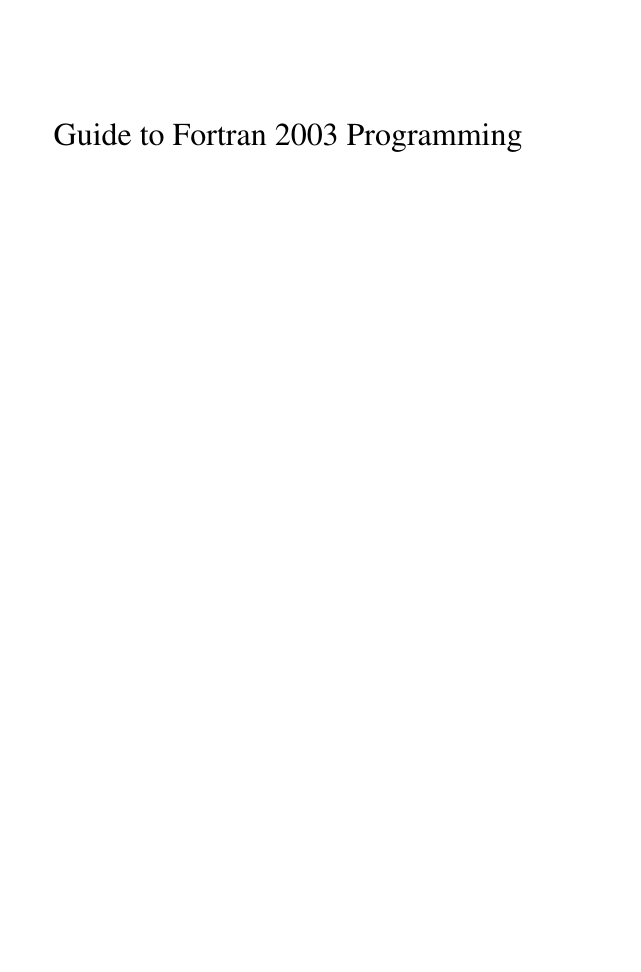
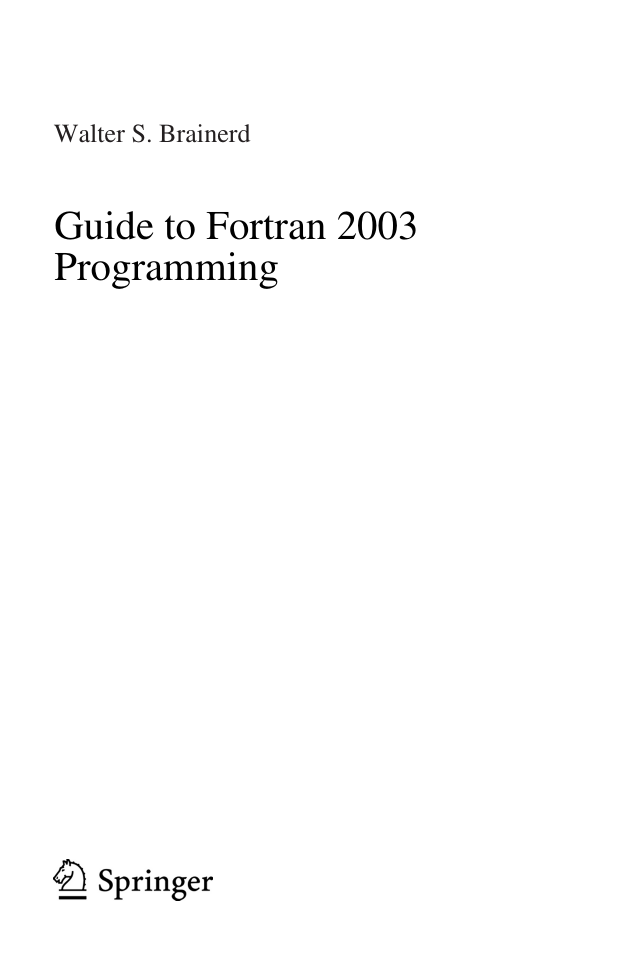
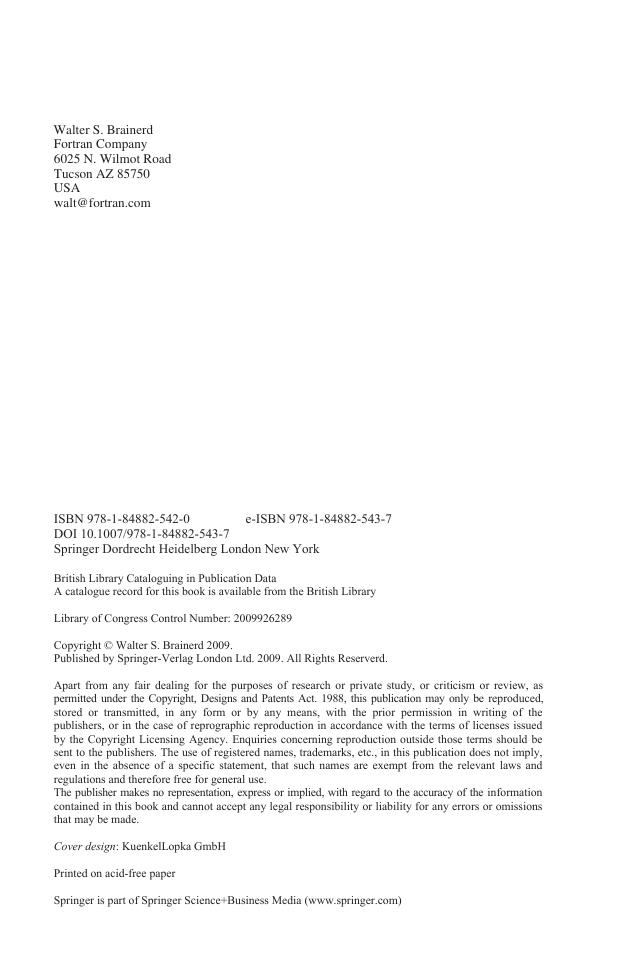
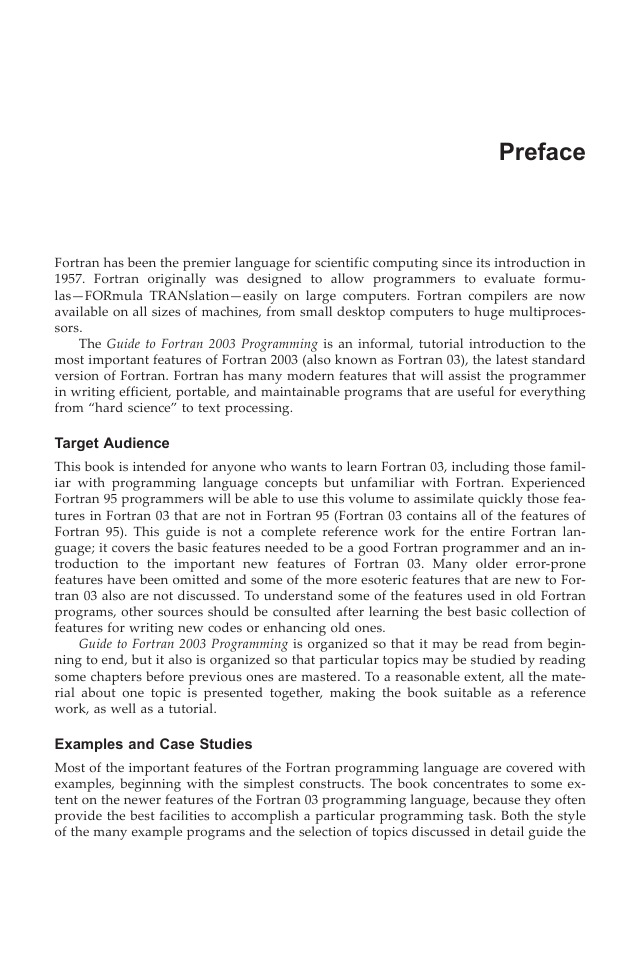
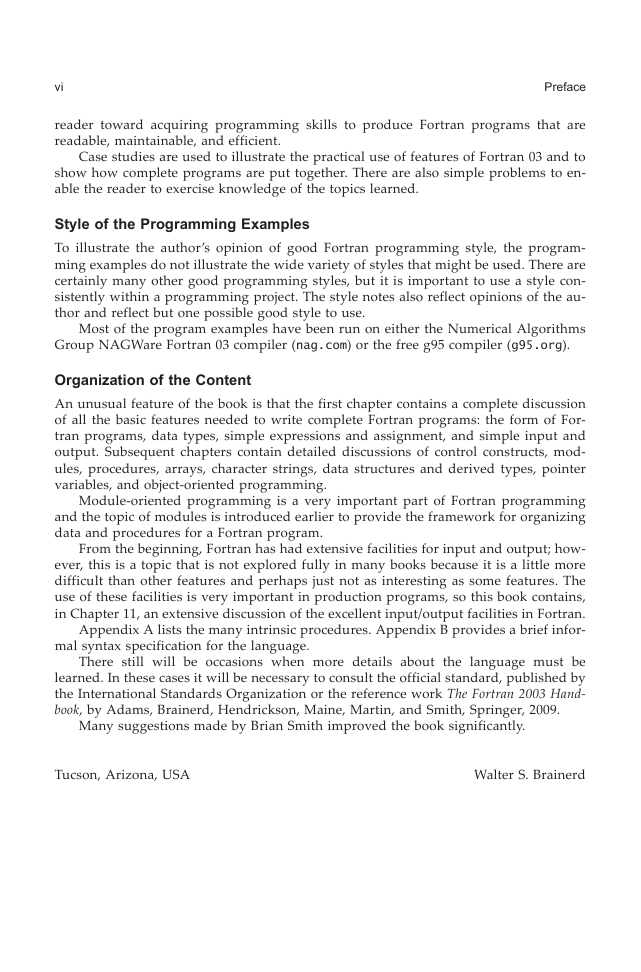
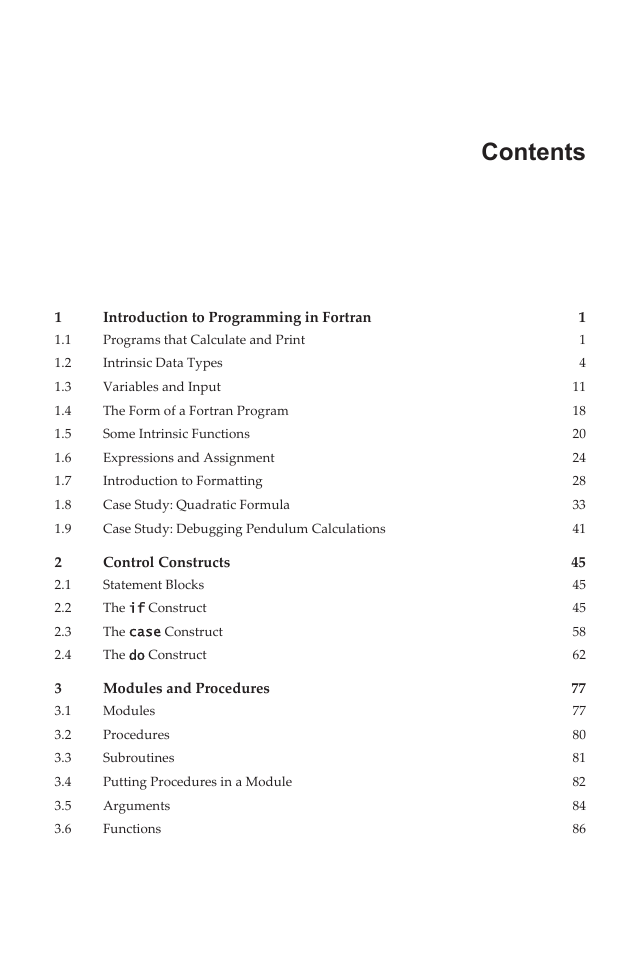

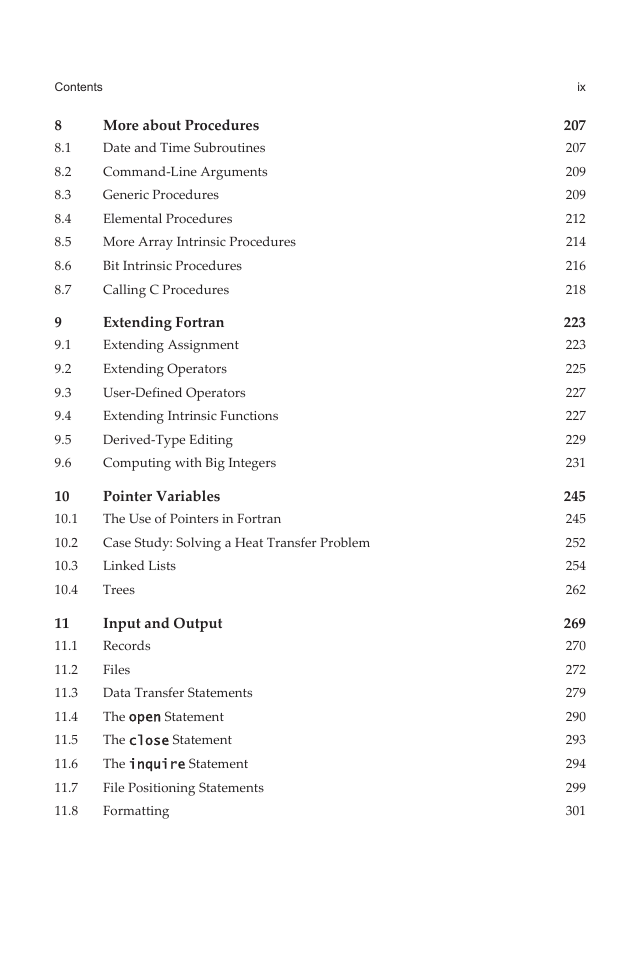








 2023年江西萍乡中考道德与法治真题及答案.doc
2023年江西萍乡中考道德与法治真题及答案.doc 2012年重庆南川中考生物真题及答案.doc
2012年重庆南川中考生物真题及答案.doc 2013年江西师范大学地理学综合及文艺理论基础考研真题.doc
2013年江西师范大学地理学综合及文艺理论基础考研真题.doc 2020年四川甘孜小升初语文真题及答案I卷.doc
2020年四川甘孜小升初语文真题及答案I卷.doc 2020年注册岩土工程师专业基础考试真题及答案.doc
2020年注册岩土工程师专业基础考试真题及答案.doc 2023-2024学年福建省厦门市九年级上学期数学月考试题及答案.doc
2023-2024学年福建省厦门市九年级上学期数学月考试题及答案.doc 2021-2022学年辽宁省沈阳市大东区九年级上学期语文期末试题及答案.doc
2021-2022学年辽宁省沈阳市大东区九年级上学期语文期末试题及答案.doc 2022-2023学年北京东城区初三第一学期物理期末试卷及答案.doc
2022-2023学年北京东城区初三第一学期物理期末试卷及答案.doc 2018上半年江西教师资格初中地理学科知识与教学能力真题及答案.doc
2018上半年江西教师资格初中地理学科知识与教学能力真题及答案.doc 2012年河北国家公务员申论考试真题及答案-省级.doc
2012年河北国家公务员申论考试真题及答案-省级.doc 2020-2021学年江苏省扬州市江都区邵樊片九年级上学期数学第一次质量检测试题及答案.doc
2020-2021学年江苏省扬州市江都区邵樊片九年级上学期数学第一次质量检测试题及答案.doc 2022下半年黑龙江教师资格证中学综合素质真题及答案.doc
2022下半年黑龙江教师资格证中学综合素质真题及答案.doc